Definition: The span of control in management suggests estimating the optimum number of subordinates managed by a single supervisor. It is a primary factor that determines the shape of the organization. Also, it involves all the management activities than just supervision and control.
The levels of management are created based on the span of control expressed by comparing managers with employees. It depicts the organization’s size and workgroups.

The span of control can interchangeably termed as:
- Span of Management
- Span of Supervision
- Span of Authority
There are two types of span- wide and narrow span of control, determined by the manageable number of personnel under one senior. However, it differs under different circumstances based on variables like:
- Degree of autonomy granted to employees.
- Number of layers in the organization structure.
- Nature of work.
- Need for supervision, etc.
Content: Span of Control in Management
Types of Span of Control
Generally, two types of span can be seen in organizations that are:
- Wide Span of Control
- Narrow Span of Control
Wide Span of Control
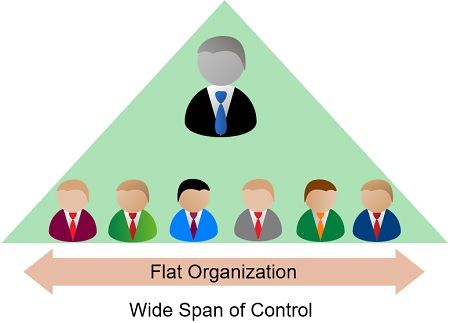
When one manager supervises many subordinates, it shows a wide span of control. It is also called Operative Span as it is generally applicable at the lower or operating managerial level.
The wide span involves simple working and forms a flatter organizational structure. Besides the organizations large in size go for a wide span of control.
It involves less operating cost and is highly adaptive to the changes. The supervisors have excellent coordination and communication horizontally & vertically because of the fewer levels.
Advantages of Wide Span of Control
- Cost-effective in nature.
- Suitable for large organizations.
- Effective communication within the organization.
- Reduced Planning time.
- Results in the flatter organizational structure.
- Subordinates are well-trained.
Disadvantages of Wide Span of Control
- Confusion among the subordinates.
- Difficulty in management if the number is considerably large.
- Requirement of qualified superior.
- Delegation of authority may be difficult at lower levels.
Narrow Span of Control
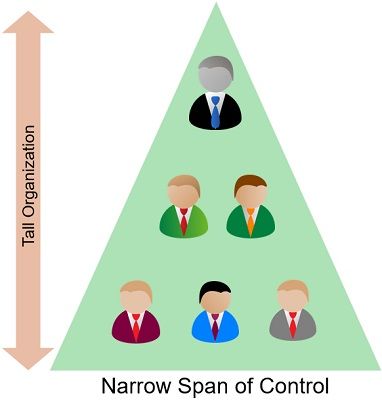
When one manager manages a few subordinates, it shows a narrow span of control. It is also called the Executive span because it is applicable at the top or middle managerial level.
Organizations opt narrow span when the nature of work is complex and requires more assistance from the superior.
A narrow span contains fewer subordinates at a single level. Consequently, it increases the number of management levels making an organization taller in structure.
Advantages of Narrow Span of Control
- Ease in management.
- Improved control of management.
- Effective Supervision.
- Suitable for work complex in nature.
- Creativity in planning and decision making.
Disadvantages of Narrow Span of Control
- High cost as more number of managers are appointed.
- Increased levels of management in the organization.
- Delay in communicating information from top to bottom.
- Delay in decision-making.
Importance of Span of Control
- Discipline
By specifying the span of control at every management level, stakeholders can create discipline within the organizations. - Motivation
Motivation is a crucial factor that keeps the team going. One can motivate its workforce through the span of control by providing guidance and feedback at regular intervals. - Timely Decision Making
Many small or big business decisions have to be taken at every hierarchy. The determination of the span of management helps in timely decision-making. - Effective Control
Control is an essential principle of management. Managers use the span of control to achieve effective control over the business. - Communication
Business communication is how individuals interact within the business. To attain effective communication, organizations use the span of control. It eases the communication flow and sends information to the lower levels of management.
Factors Affecting Span of Management
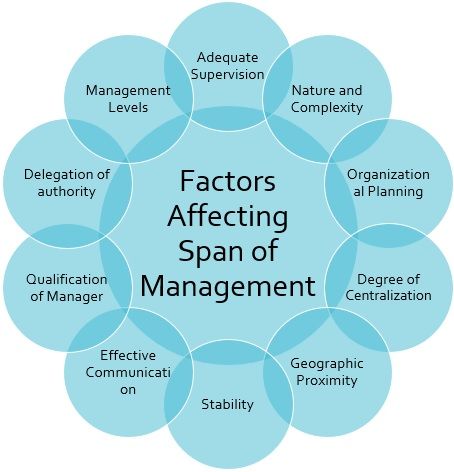
- Adequate Supervision
The managers’ span should be determined to achieve adequate supervision. The employees who need more guidance can be placed under a narrow span. - Nature and Complexity
A narrow span is suitable when the nature of work is complex and needs more focused supervision. In contrast, a wide span is suitable for repetitive work that is less complex. - Organizational Planning
The span of management is one of the critical factors of corporate planning. It clarifies the reporting relationships among superiors and subordinates in the organization. - Degree of Centralization
The degree of centralization and decentralization impacts the span of management. As centralized organizations have a narrow span of management and vice versa. - Geographic Proximity
The scattered organization results in a narrow span as supervision is required at every location. Whereas the organization situated at a single premise can use a wide span of management. - Stability
The organizations running for a long term generally have a wide span, as their goals are clearly defined, and the nature of work is known to all. - Effective Communication
A specified span of control can result in effective communication in the organization. It reduces confusion, and communication takes place through a proper channel. - Qualification of Manager
The span of control largely depends on the capability of the manager or superior. If the superior is more qualified, he can handle more numbers subordinated under him. Whereas, if he is less capable, he can only supervise a few subordinates under him. - Delegation of Authority
Appropriate delegation of authority may be achieved by defining the number of subordinates at each management level. - Management Levels
The greater the number of management levels, the narrower the span of management. The lesser the number of management levels, the wider the span of control.
Graicunas Theory of Span of Control
Traditionally theorists suggested that ideally, one executive can handle three to eight subordinates. But the experts disagree with this recommended number of associates. Moreover, they believe it cannot be specified and varies based on the situation.
In 1933 a French management consultant V.A Graicunas identified several relationships between an executive and his associates.
In his theory, he suggested a mathematical formula to ascertain the geometric increment in the number of relationships with an increase in the number of subordinates under a single supervisor.
He pointed out three types of relationships:
- Direct Single Relationships
- Direct Group Relationships
- Cross Relationships
Direct Single Relationships
It shows the number of direct individual relationships with the subordinates. The number of relationships equals the number of subordinates under a superior.
For example, a manager ‘P‘ has three subordinates, R, S and T.
The direct relationships between them will be as follows:
- P with R
- P with S
- P with T
Three direct relationships exist between them.
Direct Group Relationships
It depicts all possible relationships between the superior and his subordinates.
Based on the example given above, the number of direct group relationships will be:
= 3(2(3-1) -1)
= 9
Following will be the relationships between P, R, S and T:
- P with R in the presence of S
- P with R in the presence of T
- P with R in the presence of S and T
- P with S in the presence of R
- P with S in the presence of T
- P with S in the presence of R and T
- P with T in the presence of R
- P with T in the presence of S
- P with S in the presence of R and S
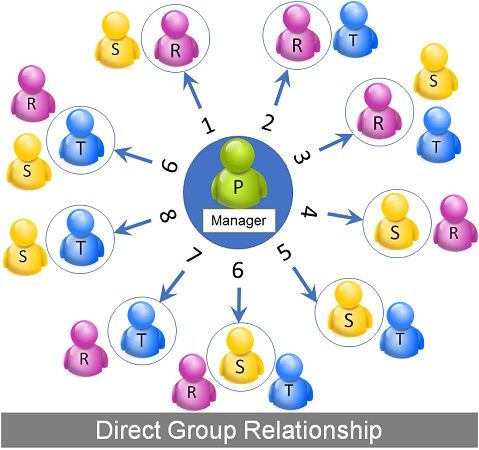
Cross Relationships
It shows the interpersonal relationships between the subordinates under a single executive. The subordinates also interact with each other in the organization. The conflicts and issues between them must be taken care of by the superior heading them.
The cross-relationship in the above example will be:
=3(3-1)
=3(2)
=6
Six cross relationships between P, R, S and T are as follows:
- R with S
- S with R
- S with T
- T with S
- R with T
- T with R
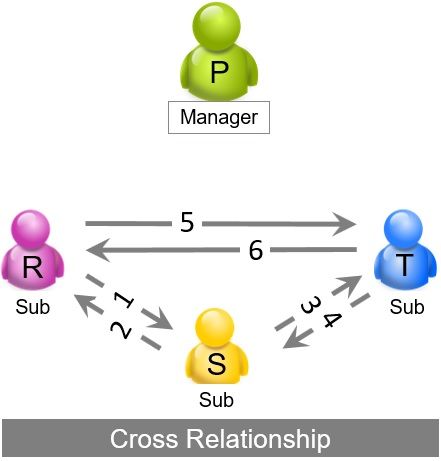
Total Relationships
The total number of relationships which can exist under an executive can be calculated using the formula given below:
Total Relationships = n(2(n-1) + n – 1) or n(2n/2 + n – 1)
The total relationships for the preceding example will be:
= 3(2(3-1) + 3 – 1)
= 18
According to Graicunas, a supervisor must thoughtfully increase his span. The complexity and number of relationships increase with every addition, which may become challenging to manage.
He also prescribed that a manager can manage up to 222 relationships under him, which means his span of control will be 6. One can effectively manage 6 subordinates under him.
Example
Coca-Cola
The span of control in Coca-Cola is narrow, creating a tall organizational structure. They have 1 superior over every 3-5 employees.
Earlier, the ratio of span of control in Google was 1 supervisor over 7 subordinates. They have widened their structure by increasing their span by 10 subordinates under 1 supervisor.
Final Words
The number of employees that a manager can effectively control implies the span of control in management. Depending upon the situation and need, organizations can use a wide or narrow span of management.
There is no predetermined number of subordinates a superior can manage. It largely depends on the various factors discussed above. It is observed that large organizations have both wide and narrow spans within the same organization.
The top and middle levels possess a narrow span, whereas the lower level includes a wide span of control.
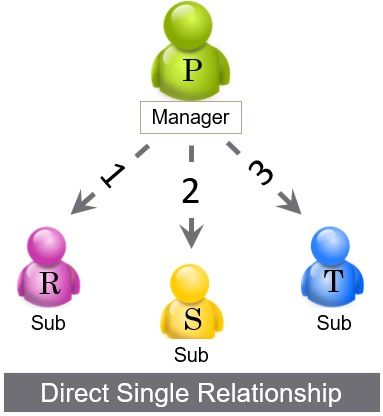
sk says
Thank you
Your content is awesome.
MANISHI GUHA says
Great content. I use it for my classes